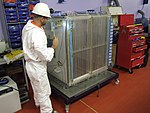ZEPLIN-III

The ZEPLIN-III dark matter experiment attempted to detect galactic WIMPs using a 12 kg liquid xenon target. It operated from 2006 to 2011 at the Boulby Underground Laboratory in Loftus, North Yorkshire. This was the last in a series of xenon-based experiments in the ZEPLIN programme pursued originally by the UK Dark Matter Collaboration (UKDMC). The ZEPLIN-III project was led by Imperial College London and also included the Rutherford Appleton Laboratory and the University of Edinburgh in the UK, as well as LIP-Coimbra in Portugal and ITEP-Moscow in Russia. It ruled out cross-sections for elastic scattering of WIMPs off nucleons above 3.9 × 10−8 pb (3.9 × 10−44 cm2) from the two science runs conducted at Boulby (83 days in 2008 and 319 days in 2010/11). Direct dark matter search experiments look for extremely rare and very weak collisions expected to occur between the cold dark matter particles that are believed to permeate our galaxy and the nuclei of atoms in the active medium of a radiation detector. These hypothetical elementary particles could be Weakly Interacting Massive Particles, or WIMPs, weighing as little as a few protons or as much as several heavy nuclei. Their nature is not yet known, but no sensible candidates remain within the Standard Model of particle physics to explain the dark matter problem.
Excerpt from the Wikipedia article ZEPLIN-III (License: CC BY-SA 3.0, Authors, Images).ZEPLIN-III
Whitby Road,
Geographical coordinates (GPS) Address Nearby Places Show on map
Geographical coordinates (GPS)
| Latitude | Longitude |
|---|---|
| N 54.5534 ° | E -0.8245 ° |
Address
Whitby Road
TS13 4UJ
England, United Kingdom
Open on Google Maps









